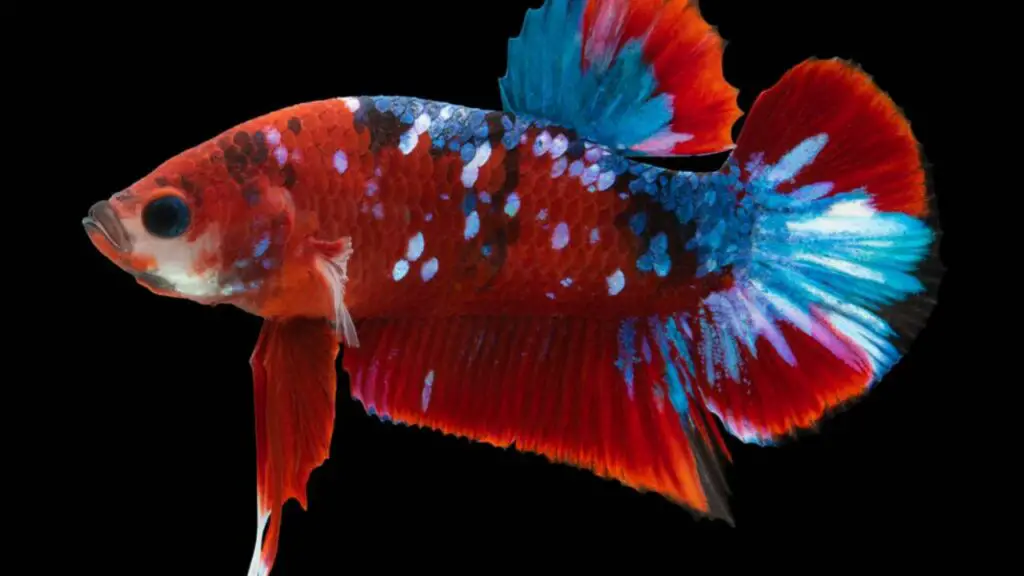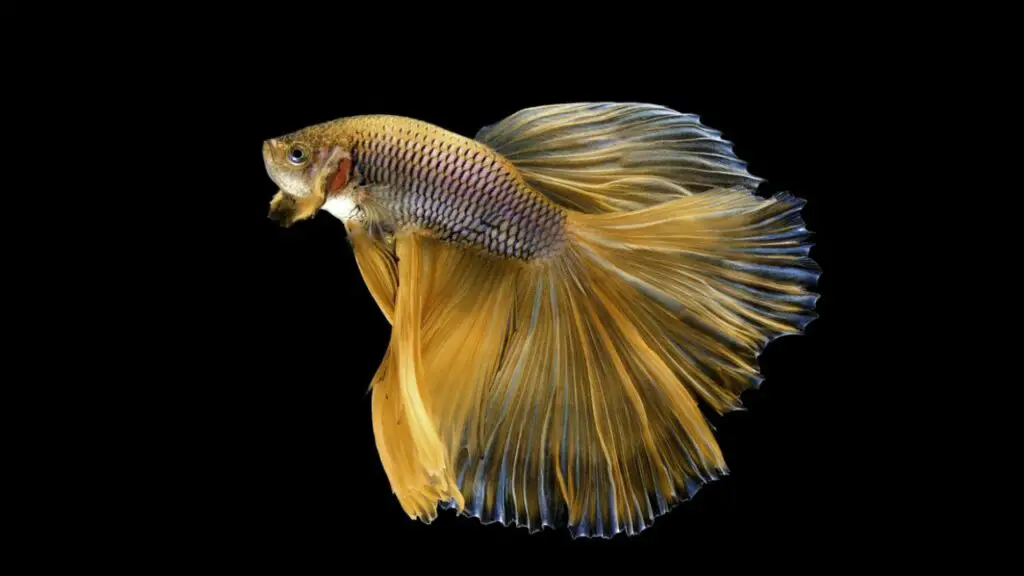The Plakat Betta fish, also known as Betta splendens, originates from Southeast Asia, specifically in the warm, shallow waters of Thailand, Cambodia, and Malaysia. They evolved in rice paddies, narrow streams, and flooded fields. These freshwater habitats provide warm water which they prefer. A high level of adaptation enables them to thrive in environments with low oxygen levels. Wild Plakat Betta fish often exhibit dull green and brown colors, contrasting significantly from the vibrant colors bred in captivity over centuries.
Characteristics and Physical Appearance of Plakat Betta Fish
Plakat Betta fish are identified by their short and stocky bodies, making them quite sturdy and resilient compared to other Betta types. Their appearance is distinguished by round bodies with short, broad tails that resemble the traditional Thai flag–a trait that their other name, “Thai flag Betta”, emphasizes. Typically, their vibrant hues range from deep blues and reds to bright yellows and purples. Plakat Betta fish possess sparkling, expressive eyes and a compact, muscular physique, exuding a peculiar blend of adorable and fierce looks.
Ideal Tank Conditions and Setup
An ideal tank setup prioritizes size, location, equipment, and decorations. The tank size should be sufficient for your fish’s growth and movement. It needs to be placed away from direct sunlight to prevent excess algae growth and harmful temperature fluctuation. Essential equipment like a filter, heater, and lighting should be properly installed for water purification, maintaining a stable temperature, and simulating a natural light cycle. Decorations should include plants and hiding spots for fish to mimic their natural habitat. Overall, a well-set-up tank ensures healthy and active aquatic life.
Plakat Betta Fish Feeding Guidelines
Plakat Betta Fish need a diet mainly consisting of proteins. Typically, they are fed with Betta-specific pellets because they provide a balanced diet. However, variety is healthy, so incorporate treats like daphnia, brine shrimp, or blood worms. Feed adult Bettas twice a day, giving only as much as they can consume in two minutes to avoid overfeeding. Juvenile Bettas, require more frequent feedings. Removing uneaten food is crucial to prevent water contamination. Remember, Bettas have small stomachs, roughly the size of their eye, so moderation is key.
Understanding the Behavior of Plakat Betta Fish
Understanding the behavior of Plakat Betta fish, a captivating species, is crucial for maintaining their healthy lifestyle. They exhibit a fascinatingly complex array of behaviors, like their unique style of swimming and territorial display. Plakats are often more aggressive than their longer-finned counterparts, making them enthralling to observe. They require solitary housing, as their territorial nature could lead to fights. Also, they show curiosity in their environment by exploring and interacting with accessories in their tank. Understanding and catering to these behavioral patterns ensures a happy and vibrant Plakat Betta.
Health and Disease Prevention Methods
Maintaining good health is vital and can be achieved through various disease prevention methods. Proper nutrition, regular physical exercise, and adequate sleep are essential for maintaining optimal health. Regular check-ups can detect diseases early, increasing the chances of successful treatment. Immunizations are also crucial in preventing infectious diseases. Moreover, adopting healthy habits such as hand hygiene and avoiding harmful substances like tobacco and excessive alcohol can significantly reduce the risk of chronic diseases. Ultimately, leading a healthy lifestyle is pivotal in disease prevention.
Breeding of Plakat Betta Fish
Recognizing mating behaviors and signs is vital in the animal kingdom, which can also be observed in domesticated pets. These signs could vary from showcasing physical affection, certain postures, distinctive calls, and specific scents. Animals typically exhibit these behaviors to attract a mate, assert dominance, or mark territory. As pet owners, understanding these behaviors is crucial to both acknowledge the instincts of your pet and also accommodate their needs during their mating cycle. Additionally, it can also prevent unwanted behavior or overbreeding.
The Breeding Process of Plakat Betta Fish
Plakat Betta fish breeding is a fascinating process. It starts when the male builds a bubble nest, which serves as a housing place for the eggs. The female is introduced to the male after his nest is built, and if she’s receptive, courtship begins. After an embrace, the female releases eggs which the male fertilizes and places in the nest. The male then shuns the female away and assumes the responsibility of guarding and caring for the eggs until they hatch into fry, showcasing the unique maternal instincts of Plakat Betta fish.
Caring for Betta Fish Fry
Caring for Betta fish fry is an intricate process that requires patience and precise attentiveness. First, provide a clean, comfortable environment for your tiny bettas in a separate breeding tank, and feed them a diet of infusoria or liquid fry food at least twice a day for proper growth. It is also essential to monitor water conditions closely, maintain optimal temperature for Betta fry, and regularly change a part of the water to mitigate build-ups. Lastly, monitor them for disease or undesirable behavior to ensure the well-being of each thriving Betta fry.
Understanding the Most Active Years of Plakat Betta Fish
Plakat Betta fish, also known as Siamese Fighting Fish, are renowned for their vibrant color, long fins, and aggressive behavior, particularly during their most active years, which are typically between 1 and 3 years of age. During these years, they exhibit peak levels of energy, aggression, and vibrancy, engaging actively in food hunting and territory defense. Their color also shines the brightest, attracting much admiration from enthusiasts. However, understanding and catering to their needs during these active years is vital for ensuring their health and well-being.
Average Lifespan in Adequate Living Conditions
Inadequate living conditions, the average lifespan tends to increase due to better health and welfare provisions. Good hygiene, access to clean water and food, regular exercise, and clean air play a critical role in enhancing longevity. Advanced medical care and preventative medicines further increase life expectancy by combating diseases. Education and stress-free mental conditions also contribute positively. As per World Bank data, the average global lifespan in excellent living conditions has increased to approximately 72.6 years, demonstrating the impact of suitable living environments on human lifespan.
Suitable Tank Mates for Plakat Betta Fish
Plakat Betta fish are known for their bright colors and aggressive behavior, often making finding compatible tank mates a challenge. Ideal companions include mild-mannered creatures such as Corydoras catfish, Ghost shrimp, and Neocaridina shrimps due to their non-threatening nature. Fish like Harlequin Rasboras and Tetras, with their faster swimming pace, can also coexist with Bettas. Snails also make good companions, as they occupy a different space within the tank. Avoid housing Plakat Bettas with flashy and slow-swimming fish, as they can trigger aggressive responses.
Decoding Betta Aggression: The Power of the Plakat
The Plakat Betta Fish, specifically the shorter-tailed variant, is often considered the most aggressive type of Betta. Despite their beautiful appearance, they tend to exhibit higher levels of aggression due to their genetics, stemming from their history as fighting fish in Southeast Asia. Their short-tail feature enhances their agility and strength used for establishing territorial dominance, making them more barricading and confrontational. However, the aggression level may vary per individual fish since environment and upbringing play significant roles too.




Leave a Reply